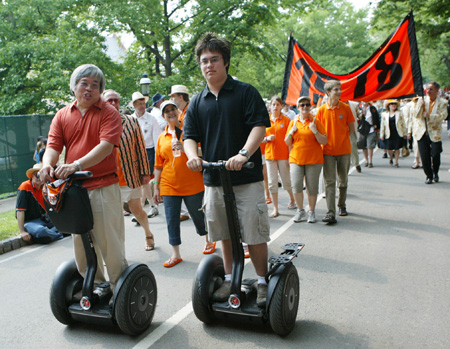
These days, alumni don’t even need to walk in the P-rade. Here, two Class of 1977 P-raders roll in style via Segway.
Photo: Andrea Kane

These days, alumni don’t even need to walk in the P-rade. Here, two Class of 1977 P-raders roll in style via Segway.
Photo: Andrea Kane
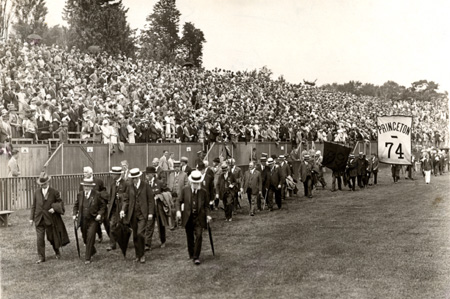
Old Guard, 1924. Members of the Class of 1873 and earlier lead the way for the 50th Reunion Class of 1874.
According to Alexander Leitch ‘24 in A Princeton Companion the tradition of alumni parading through campus began shortly after the Civil War, when those who returned for Commencement walked in procession to a dinner meeting. Over the next few decades, alumni sometimes marched informally behind the band to the Princeton-Yale baseball game on the Saturday before Commencement. In 1897, inspired by a torchlight procession held at the Sesquicentennial celebration the previous fall, alumni organized to fall in and march behind the band to the Saturday game, and the P-rade was born.
Photo courtesy of Princeton University Archives.
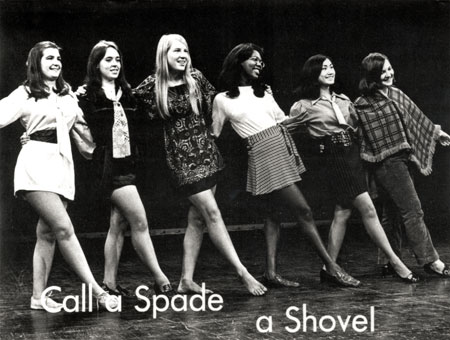
Wait! These look like real girls! Is nothing sacred? Did this Triangle production in the 1970s include a traditional kickline-in-drag as well?
To see the famous all-male kickline, come to the Triangle Reunions show, an encore performance of “A Turnpike Runs Through It,” running May 30 and 31 at the McCarter Theatre.
Photo courtesy of Princeton University Archives.
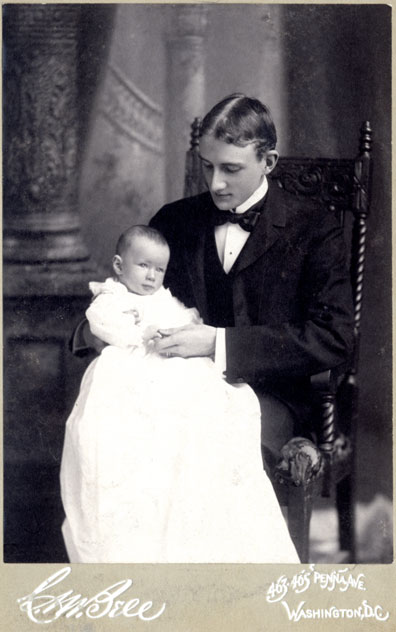
George C. Fraser Jr. is designated “Class Boy” on the back of this card, where he is shown with his proud young father, George C. Fraser, Class of 1893. Perhaps this photo made its way into the 1893 Bric-a-Brac yearbook.
Photo courtesy of Princeton University Archives.
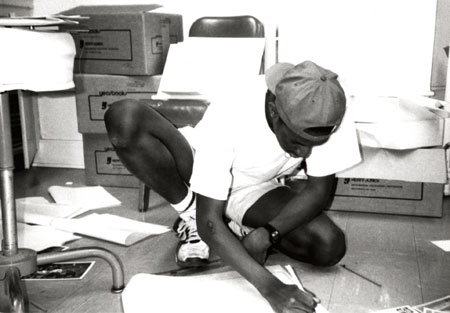
Student working on the undergraduate yearbook, the Bric-a-Brac, circa 1990s.
The Bric-a-Brac first appeared in 1876. According to Alexander Leitch in A Princeton Companion, the founding editors hoped their “compact and comprehensive summary of every feature of the college” would help fill the gap left by the college catalogue, which, they felt, did not sufficiently represent the interests of undergraduates.
One Bric editor, Mahlon Pitney ‘1879, became a supreme court justice. Several became college presidents: John Grier Hibben ‘1882 (Princeton), Robert C. Clothier ‘08 (Rutgers), Henry P. Van Dusen ‘19 (Union Theological Seminary), Paul Havens ‘25 (Wilson). A few became writers, editors, or publishers: Booth Tarkington ‘1893, Ernest Poole ‘02, Maxwell Struthers Burt ‘04, Peter Schwed ‘32, Donald Clive Stuart, Jr. ‘35, and Andrew Turnbull ‘42.
Photo courtesy of Princeton University Archives.
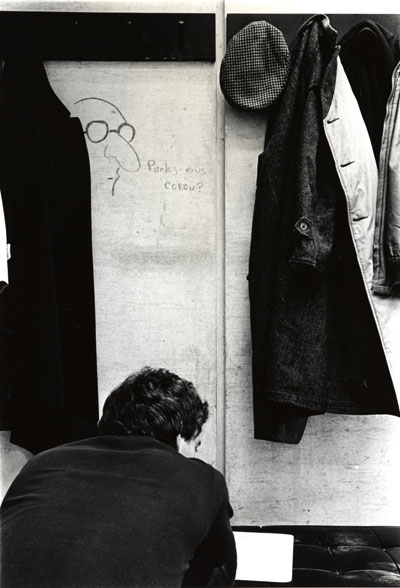
Studying, circa 1970.
Today marks the beginning of spring term final exams and senior departmental comprehensive exams. Good luck to all!
Photo courtesy of Princeton University Archives.
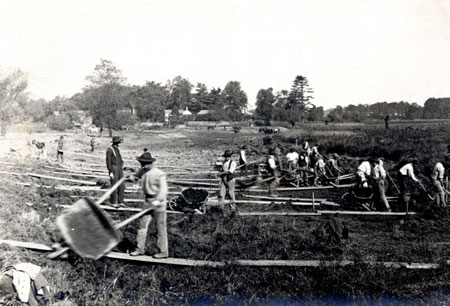
Lake Carnegie was constructed in 1906 as the result of a conversation between Howard Russell Butler, Class of 1876, and industrialist Andrew Carnegie. Butler, a member of the crew team, described the difficulty of rowing on the narrow and heavily trafficked Delaware and Raritan Canal. The idea of using the Stony Brook and Millstone River to create a lake between Princeton and Kingston appealed to Carnegie, who funded the enterprise as a gift to the University. The project involved clearing trees, excavating up to two feet of earth, and then building a 650-foot dam as well as four bridges.
Now a much-loved feature of the landscape, Lake Carnegie is used for regular practice and for competitions by four Princeton crew teams—men’s heavyweight, women’s open, and men’s and women’s lightweight—all of whom will be competing this coming weekend at the annual Eastern Sprints Regatta.
Photo courtesy of Princeton University Archives.
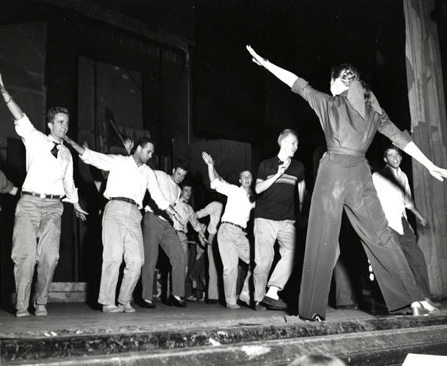
Members of the Triangle Club rehearsing choreography, circa 1940s.
F. Scott Fitzgerald wrote in This Side of Paradise, “A great seething anthill was the Triangle Club. It gave a musical comedy every year, traveling with cast, chorus, orchestra, and scenery all through the Christmas vacation. The play and music were the work of undergraduates, and the club itself was the most influential of institutions, over three hundred men competing for it every year.”
Triangle’s spring show runs from May 8-10, 2008 at Frist Campus Center.
Photo courtesy of Princeton University Archives
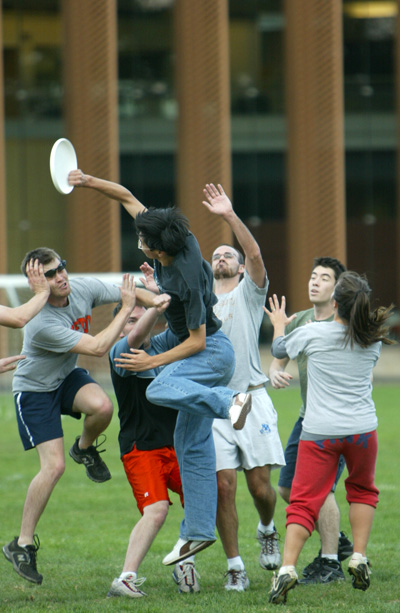
The return of warm weather brings students out to Princeton’s many green spaces. Here on Poe Field, in the shadow of Icahn Laboratory, Jason Yun ’10 successfully snatches a frisbee away from the hands of many would-be interceptors.
Photo: Andrea Kane
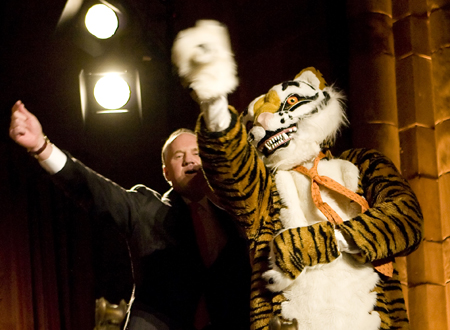
Aspire Campaign Co-Chair Robert S. Murley ’72 and the Princeton mascot sing “Old Nassau.”
According to Alexander Leitch in A Princeton Companion, a few days after the words and music to “Old Nassau” were published in a collection in April 1859, a group of students gathered at the northeast corner of Nassau Hall to try some of the songs. Most of the college had gathered to listen and when the group finished “Old Nassau,” the listeners responded with an enthusiastic skyrocket cheer, which forecast the devotion with which succeeding generations of Princetonians would sing “in praise of old Nassau.”
Photo: Steve Freeman